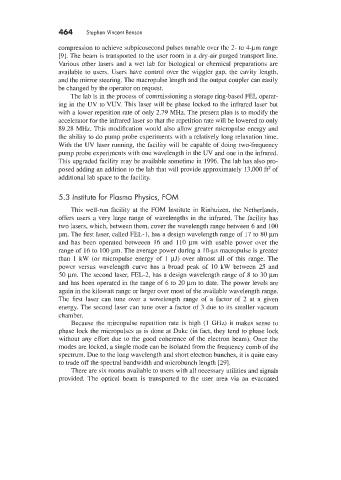Page 504 - Tunable Lasers Handbook
P. 504
464 Stephen Vincent Benson
compression to achieve subpicosecond pulses tunable over the 2- to 4-pm range
[9]. The beam is transported to the user room in a dry-air purged transport line.
Various other lasers and a wet lab for biological or chemical preparations are
available to users. Users have control over the wiggler gap. the cavity length,
and the mirror steering. The macropulse length and the output coupler can easily
be changed by the operator on request.
The lab is in the process of commissioning a storage ring-based FEL operat-
ing in the UV to VUV. This laser will be phase locked to the infrared laser but
with a lower repetition rate of only 2.79 MHz. The present plan is to modify the
accelerator for the infrared laser so that the repetition rate will be lowered to only
89.28 MHz. This modification would also allow greater micropulse energy and
the ability to do pump probe experiments with a relatively long relaxation time.
With the UV laser running, the facility will be capable of doing two-frequency
pump probe experiments with one wavelength in the UV and one in the infrared.
This upgraded facility may be available sometime in 1996. The lab has also pro-
posed adding an addition to the lab that will provide approximately 13,000 ft’ of
additional lab space to the facility.
5.3 Institute for Plasma Physics, FOM
This well-run facility at the FOM Institute in Rinhuizen, the Netherlands.
offers users a very large range of wavelengths in the infrared. The facility has
two lasers, which, between them, cover the wavelength range between 6 and 100
pm. The first laser, called FEL-1, has a design wavelength range of 17 to 80 pm
and has been operated betweeen 16 and 110 pm with usable power over the
range of 16 to 100 pm. The average power during a 10-ps macropulse is greater
than 1 kW (or micropulse energy of 1 pJ) over almost all of this range. The
power versus wavelength curve has a broad peak of 10 kW between 25 and
50 pm. The second laser, FEL-2, has a design wavelength range of 8 to 30 pm
and has been operated in the range of 6 to 20 pm to date. The power levels are
again in the kilowatt range or larger over most of the available wavelength range.
The first laser can tune over a wavelength range of a factor of 2 at a given
energy. The second laser can tune over a factor of 3 due to its smaller vacuum
chamber.
Because the mircopulse repetition rate is high (1 GHz) it makes sense to
phase lock the micropulses as is done at Duke (in fact, they tend to phase lock
without any effort due to the good coherence of the electron beam). Once the
modes are locked, a single mode can be isolated from the frequency comb of the
spectrum. Due to the long wavelength and short electron bunches, it is quite easy
to trade off the spectral bandwidth and microbunch length [29].
There are six rooms available to users with all necessary utilities and signals
provided. The optical beam is transported to the user area via an evacuated

